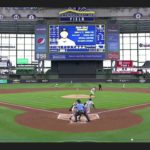NCAA 2-55 Obstruction
Obstruction
SECTION 55. The act of a fielder who, while not in possession of or in the act of fielding the ball, impedes the progress of any runner.
See specific rule sections for action to be taken: catcher (8-2-e); fielder (8-2-e, f and h, 8-3-e, f and g); visual obstruction (8-3-f).
Type 1 Obstruction: When obstruction by a fielder is committed against a runner on which a play is being made, the umpire shall call “That’s obstruction” while pointing at the obstruction and then signal and call “Time.” The ball is dead immediately. All runners shall be awarded bases they would have reached had there been no obstruction. The obstructed runner shall be awarded at least one base beyond his last legally touched base before the obstruction.
Type 2 Obstruction: The second type of obstruction deals with cases when a runner is obstructed while no play is being made on him. This obstruction is to be signaled by the umpire by pointing at the obstruction and calling, “That’s obstruction.” The ball is NOT dead. The umpire shall allow play to continue until all action has ceased and then call “Time” and impose such penalties that will nullify the act of obstruction.
Note 1: If the fielder is about to receive a thrown ball and the ball is in flight directly toward and near enough to the fielder so he must occupy his position to receive the throw, he may be considered “in the act of fielding the ball.”
Note 2: When a fielder has made an attempt to field a batted or thrown ball, has missed and is in pursuit of the ball, he may no longer be considered “in the act” of fielding.
Note 3: After a fielder has misplayed a batted ball and the ball is “within a step and a reach” the fielder is still considered “in the act.”
Note 4: On a play at any base, the defensive player must clearly have possession of the ball before blocking the base with any part of the defensive player’s body. The umpire will call “That’s obstruction” and then signal and call “Time.” The ball is dead immediately, and the runner being played on is awarded one base beyond the last base he had attained before the obstruction.
Note 5: When a fielder attempts to catch a wild throw, if the ball is misplayed and the runner and fielder tangle, the fielder is restricted from any further hindrance after the initial contact.
Note 6: The catcher, without the ball in his possession, has no right to block the pathway of the runner attempting to score. The base line belongs to the runner and the catcher should be there only when he is fielding the ball or when he already has the ball in his hand. If a fielder is about to receive a thrown ball and if the ball is in flight toward and near enough to the fielder so he must occupy his position to receive the ball, he may be considered “in the act of fielding” a ball. It is entirely up to the judgment of the umpire as to whether the fielder is in the act of fielding a ball.



